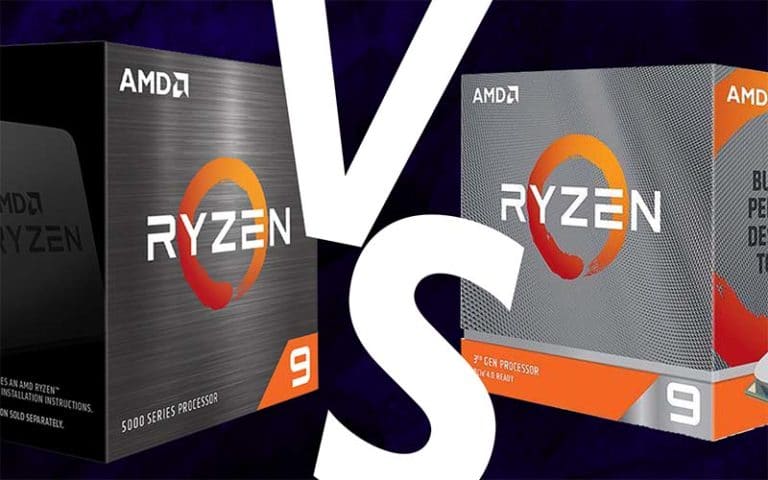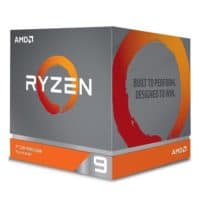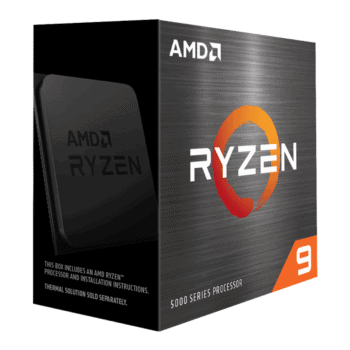
The AMD 3950X has long since been a staple for many workstations worldwide, but the newer 5950X is channeling something different.
While it still possesses all of the qualities to use on a workstation, it also has an impressive gaming performance. Let’s take a look at the two CPUs together to see which is best overall.
Specification

AMD Ryzen 9 3950X

Speed
3.5GHz/ 4.7GHz
Core (Threads)
16/32
Socket
AM4
TDP
105W
Unlocked?
Yes
PCIe Version
PCIe 4.0 x16
Total L2 Cache
8MB
Total L3 Cache
64MB
CMOS
TSMC 7nm FinFET
Max Temps
95°C
Very high single-core performance
Great for gaming and workstation tasks
Excellent overclocking potential
High price tag
Requires CPU cooler

AMD Ryzen 9 5950X

Speed
3.4GHz/ 4.9GHz
Core (Threads)
16/32
Socket
AM4
TDP
105W
Unlocked?
Yes
PCIe Version
PCIe 4.0
Total L2 Cache
8MB
Total L3 Cache
64MB
CMOS
TSMC 7nm FinFET
Max Temps
90°C
Very high single-core performance
Great for gaming and workstation tasks
Excellent overclocking potential
High price tag
Requires CPU cooler
Features
Let’s take a deeper look into these specifications to see how the 3950X and the 5950X compare against each other.
Both of these models from AMD are popular in their own right, but does newer always mean better? Let’s find out.
Architecture
AMD uses ‘Zen’ as opposed to the usual ‘Gen,’ meaning generation. The 3950X adopts the second Zen, while 5950X is based on Zen 3. Both of the architectures of these Zen’s use a 7nm process; however, there is a distinct difference between the two CPUs.
AMD focused on refining the technology on the Zen 3 architecture substantially more than that of the Zen 2. The IPC and power efficiency saw a large increase for the Zen 3 models, meaning that these are two benefits for the 5950X.
Improved architecture is often welcomed by enthusiasts, and the Zen 3 models have been well received by users. While Zen 2 was also impressive on release, why not opt for the newer and more advanced architecture?
Cores
Above we have mentioned that both the 3950X and the 5950X have 16 cores, but we didn’t yet disclaim that they were made up of cache sections. While the former has four 16 MB cache sections, with four cores each, the latter has two 32 MB cache segments, each boasting eight cores.
So, while both of the CPUs have the same amount of cores and memory, the efficiency of the two models is very different. The cache sectioning affects more than you first might think.
Rather than the 5950X having four cores that can access the L3 memory, it can now have eight cores that all access one large memory pool at the same time.
The ability to access one large memory pool rather than having to skip between separate cache segments saves time and gamer annoyance. This also reduces the latency of your games to that there is less of a delay after your instructions.
The 5950X obviously has the edge here as it has the potential to run your games much faster than the 3950X.
Base and Turbo Frequency
In the specifications, we have stated both the base frequency and the turbo frequency for the CPUs we’re comparing today.
Base frequency relates to the regular operating point of the CPU, while the turbo frequency hints at the maximum speed that the processor can achieve.
The higher the base and turbo frequency of your CPU, the faster the clock speed. While a faster clock speed often means a faster running CPU, there are some factors that can affect this. The 3950X has a base frequency of 3.5GHz, meaning that the CPU executes 3.5 billion cycles per second.
In comparison, the 5950X has a base frequency of 3.4GHz. Don’t freak out about the slight drop in frequency just yet, though. The more efficient cores of this CPU will make up for the slight decrease in frequency.
What’s more, the turbo frequency is slightly more impressive on the 5950X rather than the 3950X.
While the newer model has a turbo frequency of 4.9GHz, the 3950X only has a turbo frequency of 4.7GHz. It’s better to keep your CPU running at a slower rate to avoid overheating, but it is beneficial to have a turbo security blanket to fall back on.
Games require your CPU to boast a number of impressive features to run as smoothly as possible, so the frequencies are no longer the sole feature to look for when it comes to a gaming CPU.
However, the frequencies need to be high enough to run alongside smart cores and architectures.
Memory
Both the 3950X and the 5950X have a memory type of DDR4-3200. The first part of this type stands for ‘Double Data Rate’, and the higher the number is the faster the memory.
The bandwidth is also higher. As the two CPUs that we’re comparing have a DDR4 memory type, the generation is fourth.
3200 refers to the CPUs data transfer rate per second in millions. This is impressive in its own right, and the peak transfer rate is 25600 MB per second. The DDR4 memory types are for those who want the most out of their systems, as they offer faster speeds and better responsiveness.
These are best suited to gamers and professional designers, so both the 3950X and the 5950X can be used for gaming when it comes to memory. You won’t be waiting around to load a game and the latencies will be kept to a minimum.
Cache Memory vs Maximum Memory
When thinking about memory, we think of the information held within the CPU. However, there are also memory components that exist beyond this limit, encoding, and retrieving data to ensure that games run smoothly at all times. This is the main function of the cache memory.
Cache memory allies your CPU to retain recent information so that you can access it again quickly.
Higher cache memory is good for gaming CPUs as it means that you don’t have to continually repeat the entire process to find the same piece of information again. A larger cache memory also allows your CPU to run faster.
The maximum memory is how much data the CPU can hold altogether. Both of the CPUs that we’re looking at today have 128GB of maximum memory. This is an impressive number in terms of most computers, some of which have as little as 4GB of memory.
The most common RAM capacities of gaming computers are 16GB to 32GB, so we think that you’ll be pleasantly surprised with the memory of the 3950X and the 5950X, in terms of gaming and whatever you decide to use your computer for.
Performance
Since its release in 2019, the 3950X has quickly become one of the most used CPUs for creative entrepreneurs whose jobs have relied on the computer. Twitch streamers, video editors, and Youtubers have used this CPU to enhance their computer performance so that they can make the most out of their time.
The high core count and impressive memory were added bonuses to the 3950X users, not to mention the relatively low price for a CPU of this caliber. The newer 5950X has all of these same features and therefore performs as well as the 3950X at workstation tasks.
Both the 3950X and the 5950X are considered high-end CPUs, with high ratings and happy customers. If you were thinking of opting for one of these CPUs for gaming; however, you might not be as interested in the workload performance.
Instead, we look to benchmarking software to help us see how these two CPUs would perform with games.
Geekbench 4 is a platform that tests CPUs in a number of different ways, such as with images, data compression, 3D object simulation, photo editing, SQL encoding, PDF file rendering, Fast Fourier Transform, and matrix computation.
Using the 3950X and 5950X CPUs on a Windows computer shows that in a single-core there is a difference between the two of 23%. However, in a multi-core, there is only a difference of 1%. Similarly, running them on macOS shows a single-core difference of 57% and a multi-core gap of 34%.
While more games are starting to use multi-core processing power, the majority of them are still only using single-core processors. The 5950X has the best of both worlds when it comes to its processing powers, so you can use it for both gaming and heavier tasks.
An interesting difference between the 3950X and the 5950X CPUs is that the latter is up to 20% faster than the former. This difference is sure to please gamers who are not in the market for a lagging CPU. If you are looking for a fast CPU to run various games, we think that 5090X is a great choice.
AMD themselves released gaming performance statistics between the 3950X and the 5950X CPUs, showing that the latter beat the former from 14 to 29% in performance for four different games.
While this is interesting and gives you an insight into which CPU might be better for gaming, it could also be an upselling tactic from AMD to promote their new CPU.
Pricing and Availability
As the 5950X CPU is the newer model out of the two, it shouldn’t come as a surprise that it boasts a higher price point than the 3950X of around $70.
However, the price difference is not that large, and therefore both of the CPUs are on par when you compare the price to the performance.
So, it’s down to you whether or not you decide to opt for the newer model. It might be worth noting that the cost per frame of the 3950X is $0.079, while for the 5950X, it’s $0.078. While the difference of $0.0001 does not sound like much, it all adds up in the long run!
As we’re writing this, the 3950X has plenty of stock online at Amazon, but the 5950X CPU is not currently available on the platform. While you can purchase it elsewhere online, this might be a testament to how popular the newer CPU model is.
While the 5950X is not available on Amazon currently, we assume that it will come back in stock soon – so keep an eye out.
We might suggest that you don’t wait too long to purchase it when it’s restocked as it is currently sold out. The 3950X is still in stock and available, but we don’t know how long this will continue.
As newer CPUs are released onto the market, we assume that the 5950X will be easier to come by. However, as it has only recently been released itself, many people are excited to get their hands on it.
Conclusion
Overall, we think that AMD has outdone themselves with the 3950X and the 5950X CPUs. They’re both excellently built in their own right and have an attractive price point for most gamers.
While the newer 5950X boasts a few more advanced features, such as the cache sections and the turbo frequencies, the 3950X is still an excellent contender.
Both of the CPUs have similar memory and sockets, but the 3950X is often commonly used for workstations and gaming setups. This CPU has a slightly faster base frequency than the 5950X, but the latter has a more impressive turbo frequency.
The single memory pool that the 5950X boasts is sure to make up for the slight dip in base frequency. All in all, we think that all of the signs point to the 5950X is the best CPU for gamers.
Having said that, the 3950X is still a respectable model if you’re in the market for a more inexpensive model.

